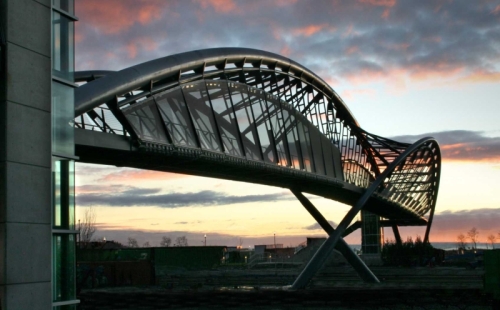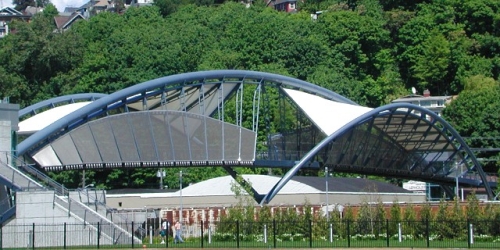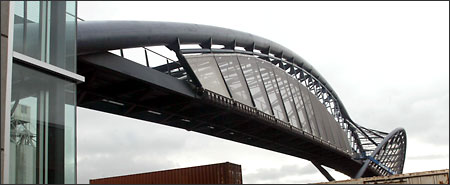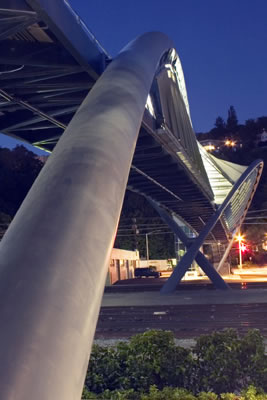세계 최대의 바이오 테크놀로지 기업인 AMGEN사는 워싱톤주 시애틀에 연구개발 단지를 설립하면서 Elliott Avenue 와 Burlington Northern Railroad를 가로질러 자사와 Elliott Bay Park를 연결하는 보도교를 구상하였다. 설계사인 Johnson Architecture와 KPFF Consulting은 ‘생명공학과 의약’이라는 AMGEN사의 이미지에 부합하는 교량 형식을 ‘유전자의 이중나선 모양을 구체화’ 시킨다는 컨셉으로 독특한 모양의 아치교인 Helix Pedestrian Bridge를 만든다.




Concepts for the pedestrian bridge were developed in a series of design meetings with Amgen, Seattle-based Johnson Architecture, and structural engineers KPFF Consulting of Seattle. Using wires and plastic foam, the design team collaborated to establish a variety of concepts for further study. A reoccurring theme was the connection between DNA, the human genome, and the structure. After exploring several ideas, the team selected a final concept with multiple arches reminiscent of DNA’s helical structure, which would reference the vital research underway at Amgen. The arches define the bridge just as sugar phosphate spirals are the backbone of the double helix. The deck support and roof trusses complete the remaining components of the helix form. [Form Follows Function]
링크한 기사의 제목을 Bridge 매거진은 “Form Follows Function”으로 땄고 기사에서는 “Like many modern pedestrian bridges, the Helix structure’s form follows its function of carrying people and connecting communities.” 라고 단 한 번만 언급한다.
“형태는 기능을 따른다(Form Follows Function)”는 근대 건축의 기능주의(functionalism)를 언급할 때 나오는 유명한 문구이다. 하지만 교량 디자인에 있어 이 문구가 함축하고 있는 것은 “carrying people and connecting communities(통행하고 지역사회를 연결)”하는 일반적인 기능을 의미하지 않는다. 이런 단순한 기능을 근거로 교량을 설계하면 수천, 수백가지의 형태가 나올 수 있다.
형태는 기능에 따른다고 할 때의 기능의 의미는 모든 사회적 제도나 규약과 규범, 그리고 그 사회의 제도나 사고의 틀을 포함하고 있다. [건축의 미니멀리즘, Korean Culture & Arts Journal | November 2005, 함성호]
기능을 어떻게 정의하냐에 따라 다르겠지만 일반적으로 교량에서 이 문구가 의미하는 것은 ‘구조적 효율성’을 따르다 보면 교량의 형태는 자연적으로(아름답게) 결정된다는 것이다.
Aesthetics are inherent in good bridge design. The classic phase, “form follows function”, is a basic principle in bridge engineering. A properly proportioned bridge is attractive. The size and shape of the structure’s components provide a definition of its purpose. That’s what people appreciate when it comes to bridge aesthetics. Innovative solutions automatically make a structure aesthetically pleasing. [Finley, R. Craig. “Five fundamentals of bridge design”. CE News 13 (August 2001): 48-49]
하지만 ‘기능주의’ 하의 교량은 ‘구조적 효율성과 경제성만을 추구하여 획일적인 모양의 형태를 낳게 된다.’라는 비판적 시각이 요즘은 대세인 것 같다.
유명한 교량 설계가인 Fritz Leonhardt교수는 “the often cited maxim, ‘form follows function,’ is misunderstood if function is only defined structurally.["The Significance of Aesthetics in Structures", Structural Engineering International, February 1996, pp. 74-76]“라 했으며, Paul Gauvreau교수는 ‘The Three Myths of Bridge Aesthetics‘에서 이를 지적하고 있다.
이러한 의미에서 보았을 때 Helix Pedestrian Bridge는 설계자의 창의적인 아이디어가 구체화되어 aesthetics을 강조한 교량이므로 “Form follows function”이 아닌 “Function follows form”이라 할 수 있다.
*Images from Johnson Architecture
One Trackback
DNA 다리…
싱가포르가 세계 최초로 ‘DNA’ 형상의 교량을 건설한다는 외신을 인용한 기사가 실렸다.
싱가포르가 세계 최초로 DNA 이중나선 모양의 다리(사진)를 건설한다. 7일 로이터통신에 따르……